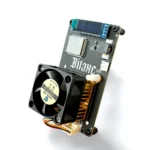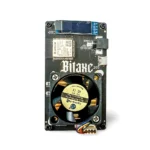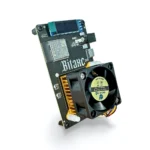How does Bitaxe Ultra compare to other solo mining hardware?
How Does Bitaxe Ultra Compare to Other Solo Mining Hardware?
The Bitcoin mining landscape has evolved dramatically over the years, transitioning from CPU and GPU mining to highly specialized ASIC (Application-Specific Integrated Circuit) miners. While large-scale mining operations dominate the scene, solo mining—where individual miners compete for block rewards independently—remains an appealing concept for decentralization purists and hobbyists alike.
Enter the Bitaxe Ultra, a revolutionary open-source ASIC miner designed specifically for solo mining. But how does it stack up against other solo mining hardware in terms of efficiency, cost, and decentralization benefits? This article provides a detailed comparison, highlighting the Bitaxe Ultra’s unique advantages and where it fits in the broader mining ecosystem.
Understanding Solo Mining Hardware: The Competitive Landscape
Before diving into the Bitaxe Ultra’s specifics, it’s essential to understand the types of hardware typically used for solo mining:
- FPGA Miners – Field-Programmable Gate Arrays offer flexibility but require technical expertise to optimize for Bitcoin mining. While more efficient than GPUs, they lag behind ASICs in raw hashing power.
- Older ASIC Miners – Devices like the Antminer S9 (14 TH/s) are still used for solo mining but consume significant power (1,300W+) compared to modern alternatives.
- USB ASIC Miners – Small, low-power miners like the GekkoScience Compac F or FutureBit Apollo are designed for hobbyists but offer minimal hashrates (a few GH/s).
- Modern ASIC Miners – High-efficiency miners like the Bitmain Antminer S19 series dominate industrial mining but are expensive and power-hungry, making them impractical for solo miners.
The Bitaxe Ultra sits in a unique niche—it’s an efficient, open-source ASIC miner designed specifically for solo miners who value decentralization, low power consumption, and community-driven development.
Bitaxe Ultra: A Deep Dive into Its Advantages
1. Unmatched Energy Efficiency (15W for 500 GH/s)
One of the biggest challenges in solo mining is profitability. Traditional ASICs consume massive amounts of electricity, making solo mining unviable unless you have extremely cheap power.

The Bitaxe Ultra solves this with its BM1366 ASIC chip, delivering 500 GH/s at just 15W. This translates to 33.3 GH/s per watt, a remarkable efficiency ratio that outperforms older ASICs (e.g., Antminer S9 at ~0.1 GH/s per watt) and even some modern industrial miners.
#### Comparison Table: Power Efficiency
| Miner Model | Hashrate | Power Consumption | Efficiency (GH/s per Watt) | |———————|———-|——————-|—————————-| | Bitaxe Ultra | 500 GH/s | 15W | 33.3 | | Antminer S9 | 14 TH/s | 1,350W | ~0.1 | | GekkoScience Compac | 100 GH/s | 10W | 10 | | Antminer S19 Pro | 110 TH/s | 3,250W | ~33.8 |
While industrial miners like the S19 Pro achieve similar efficiency, they cost thousands of dollars and require industrial power setups. The Bitaxe Ultra provides a cost-effective, low-power alternative for solo miners.
2. Open-Source Architecture: Transparency & Customization
Most ASIC miners are proprietary “black boxes,” meaning users can’t modify firmware or inspect hardware designs. The Bitaxe Ultra is the world’s first open-source ASIC miner, offering:
- Full firmware access (allowing optimizations and custom mining software).
- Community-driven improvements (users can contribute to its development).
- No vendor lock-in (unlike closed-source competitors).
This transparency is a game-changer for miners who distrust centralized mining hardware manufacturers.
3. True Solo Mining: No Pool Dependency
Most miners rely on pools to earn consistent payouts, but this centralizes Bitcoin’s hash power. The Bitaxe Ultra enables direct solo mining by:
- Processing its own block templates (no need for a pool).
- Broadcasting solved blocks directly to the Bitcoin network.
- Contributing to network decentralization by adding an independent mining node.
While the odds of finding a block solo are low, the Bitaxe Ultra makes it feasible due to its low cost and energy efficiency.
4. Compact & Flexible Deployment
Unlike bulky ASIC miners that require dedicated cooling systems, the Bitaxe Ultra is ultra-compact (10 x 6 cm, 73g) and supports:
- Standard or Noctua fan options for optimal cooling.
- Plug-and-play USB-C power (no 220V circuits needed).
- Stackable designs for scaling up hashrate.
This makes it ideal for home miners, small-scale operations, and even portable mining setups.
Bitaxe Ultra vs. Other Solo Mining Options
1. Bitaxe Ultra vs. USB Miners (GekkoScience, FutureBit Apollo)
- Hashrate: Bitaxe Ultra (500 GH/s) vs. USB miners (10-100 GH/s).
- Efficiency: Bitaxe Ultra (33.3 GH/s per watt) vs. USB miners (~10 GH/s per watt).
- Use Case: USB miners are great for learning, but the Bitaxe Ultra offers realistic solo mining potential.
2. Bitaxe Ultra vs. Older ASICs (Antminer S9, Whatsminer M3)
- Power Consumption: Bitaxe Ultra (15W) vs. S9 (1,350W).
- Profitability: Older ASICs are often unprofitable due to high electricity costs.
- Noise & Heat: Bitaxe Ultra is near-silent; older ASICs require loud cooling.
3. Bitaxe Ultra vs. High-End ASICs (Antminer S19, Whatsminer M50)
- Cost: Bitaxe Ultra (~$200) vs. S19 (~$3,000+).
- Accessibility: Bitaxe Ultra is plug-and-play; industrial ASICs need 220V power and cooling.
- Philosophy: Bitaxe Ultra supports decentralization; industrial ASICs favor large-scale mining.
Who Should Use the Bitaxe Ultra?
The Bitaxe Ultra is ideal for:
- Decentralization advocates who want to solo mine without pools.
- Hobbyists & educators looking for an open, customizable miner.
- Low-power miners seeking an efficient, silent mining solution.
- Developers who want to experiment with Bitcoin mining software.
It’s not for those seeking immediate profitability—solo mining is a lottery, and the Bitaxe Ultra is best seen as a long-term, ideological investment in Bitcoin’s decentralization.
Final Verdict: Is the Bitaxe Ultra the Best Solo Miner?
While no single miner can guarantee solo block rewards, the Bitaxe Ultra stands out as the most efficient, open, and accessible option for independent miners. Its low power draw, open-source design, and compact form factor make it a unique product in a market dominated by closed, power-hungry ASICs.

If you believe in Bitcoin’s decentralized future and want to contribute meaningfully to the network, the Bitaxe Ultra is the best solo mining hardware available today.

Would you consider using the Bitaxe Ultra for solo mining? Let us know your thoughts in the comments!